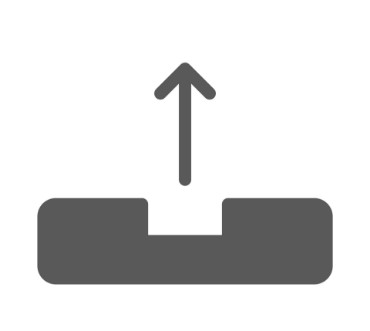Cookies help us deliver our services. By using our services, you agree to our use of cookies.
Cables & Adapters
Cables & Adapters
PC Case Switches Power/Reset with LED
APO0035
Works with most cases with front panel button. Replace your old or broken connector switch. Just connect the cable onto the motherboard, and you can switch on power or reset the motherboard. You can press the button with your bare finger without installing onto the PC Case
€2.00 incl VAT excluding shipping
Phanteks 4 pin RGB LED cable
APO0004
Phanteks’ RGB LED Adapter is a simple, frustration-free solution to the upcoming RGB integrated motherboards that includes the RGB headers. This adapter will allow you to synchronize and control the lighting of your LED strip and Phanteks cases with the motherboards’ lighting software.
€1.50 incl VAT excluding shipping
Phanteks HDD bracker 1x3.5
AMS0003
The Phanteks PH-HDDKT2 allows installation of an additional 3.5" or 2.5" drive in select Enthoo Series cases
€3.00 incl VAT excluding shipping
TapeCom C13>C14 Power Extension 2m JL-38C/JL-39C
APO0020
Computer power extension cord connects 2 devices with C13/C14 power connectors or extends your existing power connection
€2.60 incl VAT excluding shipping
TapeCom UK 3-Pin > C13 Power Cord 1.8m JL-49A/JL-38C
APO0019
Perfect for connection between PCs, displays, printers or other devices with IEC cold device ports
€3.00 incl VAT excluding shipping
TapeCom UK 3-pin > C5 (clover) Power cord 1.8m JL-49A/JL-47
APO0038
UK 3 pin plug to C5 Cloverleaf mains lead 3 x 0.75mm cores – 5 amp fuse. Most commonly used as a laptop lead.
€3.20 incl VAT excluding shipping
TapeCom UK 3-Pin > C7 Power Cord 1.8m
APO0041
A C8B inlet type (commonly known as the figure of 8) is defined by the standard for use by dual-voltage appliances; it has three pins and can hold a C7 connector in either of two positions, allowing the user to select voltage by choosing the position the connector is inserted
€2.60 incl VAT excluding shipping
TapeCom USB Power Strip TP-FA4U6K 2M, 4-Port USB and 6 Sockets with surge
APO0031
Ideal for Home desks, or office, in a sleek, minimalistic design
€19.90 incl VAT excluding shipping
TapeCom UTP CAT 5E Patch BC 24AWG 2m
ANW0038
Cat 5e cables operate on the same 100 MHz frequency as Cat 5 and have the same maximum length of 100 meters before requiring a router or powered signal booster. The primary difference between the two standards is that Cat 5 is only rated for 100 Mbps networks, while Cat 5e supports 1,000 Mbps networks.
€1.16 incl VAT excluding shipping
TapeCom UTP CAT 5E Patch CCA 24AWG Grey 10m
ANW0133
Cat 5e cables operate on the same 100 MHz frequency as Cat 5 and have the same maximum length of 100 meters before requiring a router or powered signal booster. The primary difference between the two standards is that Cat 5 is only rated for 100 Mbps networks, while Cat 5e supports 1,000 Mbps networks.
€1.57 incl VAT excluding shipping
TapeCom UTP CAT 6 Patch BC 24AWG 2m
ANW0045
From the outside, Cat 6 cables look identical to Cat 5 and Cat 5e cables. They use the same RJ45 connectors and are backward-compatible with Cat 5/5e Ethernet networks. Internally, Cat 6 cables retain the same "twisted pair" wiring scheme with eight internal wires. The primary difference between Cat 6 and Cat 5 is that Cat 6 operates at 250 MHz, while Cat 5 and 5e operate at 100 MHz. The higher frequency enables Cat 6 cables to transfer data more quickly.From the outside, Cat 6 cables look identical to Cat 5 and Cat 5e cables. They use the same RJ45 connectors and are backward-compatible with Cat 5/5e Ethernet networks. Internally, Cat 6 cables retain the same "twisted pair" wiring scheme with eight internal wires. The primary difference between Cat 6 and Cat 5 is that Cat 6 operates at 250 MHz, while Cat 5 and 5e operate at 100 MHz. The higher frequency enables Cat 6 cables to transfer data more quickly.
€2.00 incl VAT excluding shipping
TapeCom UTP CAT5E 24AWG 305m BC Grey Fluke Certified
ANW0122
Cat 5e cables operate on the same 100 MHz frequency as Cat 5 and have the same maximum length of 100 meters before requiring a router or powered signal booster. The primary difference between the two standards is that Cat 5 is only rated for 100 Mbps networks, while Cat 5e supports 1,000 Mbps networks.
€130.00 incl VAT excluding shipping
TapeCom UTP CAT5E 24AWG 305m BC White
ANW0139
High-Performance data cable ,application structured cabling, CCTV system , Alarm system , Telecom project etc. Exceeds TIA/EIA-568B.2,ISO/IEC 11801 , ETL listed. 100Base-TX,100Base-T2 and 100Base-T4 standard. Can be used for voice, integrated service data network (ISDN). Long transmission distance, small transmission loss, wear resistance, resistance to pressure
€118.00 incl VAT excluding shipping
TapeCom UTP CAT5E 24AWG 305m CCA
ANW0120
High-Performance data cable ,application structured cabling, CCTV system , Alarm system , Telecom project etc. Exceeds TIA/EIA-568B.2,ISO/IEC 11801 , ETL listed. 100Base-TX,100Base-T2 and 100Base-T4 standard. Can be used for voice, integrated service data network (ISDN). Long transmission distance, small transmission loss, wear resistance, resistance to pressure
€44.00 incl VAT excluding shipping
TapeCom UTP CAT6 23AWG 20m BC Indoor Grey Fluke Certified
ANW0167
Patch lead 20m BC
€13.00 incl VAT excluding shipping
TapeCom UTP CAT6 23AWG 2m 0.57mm CCA Indoor Grey
ANW0169
cat 6 UTP 2M patch lead
€1.00 incl VAT excluding shipping
TapeCom UTP CAT6 23AWG 305m 0.57mm CCA Indoor Grey
ANW0171
cat 6 305 roll
€44.90 incl VAT excluding shipping
TapeCom UTP CAT6 23AWG 305m BC Indoor Grey Fluke Certified
ANW0015
Tapecom 305m Cat 6
€168.00 incl VAT excluding shipping






























